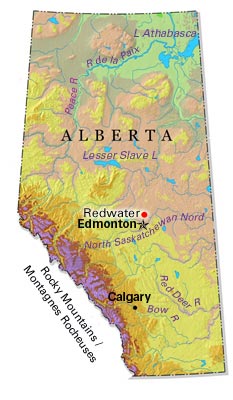Brooks, Alta, incorporated as a city in 2005, population 13 676 (2011c), 12 508 (2006c). The City of Brooks is located 185 km southeast of Calgary on the Trans-Canada Highway.
A Canadian Pacific Railway (CPR) siding was built on the site (1883), but when a townsite was surveyed in 1907, the population was only 9, including divisional engineer Noel E. Brooks, after whom the town is named. It was soon incorporated as a village (1910) and town (1911). In 1914 the CPR built a dam on the Bow River at Bassano (46 km northwest) and the Brooks Aqueduct (now a national historic site), which, at the time, was an engineering feat. Irrigation to the surrounding area encouraged settlement.
Today irrigation is still the foundation of economic development; a canal network irrigates more than 100 000 ha of prosperous farmland. Brook's largest employer is one of Canada's largest meat-processing plants. The oil and natural gas industry and the companies servicing that industry also employ many residents. A provincial agricultural research centre is located east of the city.
Brooks has one museum and a campus of Medicine Hat College. Nearby are 2 provincial parks, Kinbrook Island located on Lake Newell, Alberta's largest artificial lake, which serves as an irrigation reservoir, and Tillebrook. Dinosaur Provincial Park (40 km northeast) has some of the world's most extensive fossil remains.

 Share on Facebook
Share on Facebook Share on X
Share on X Share by Email
Share by Email Share on Google Classroom
Share on Google Classroom


